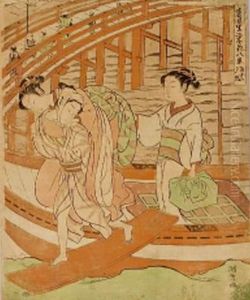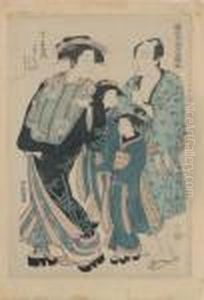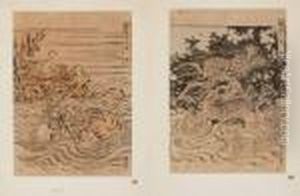Koryusai Paintings
Isoda Koryusai was a prominent Japanese ukiyo-e artist known for his woodblock prints and paintings. The details of his early life are somewhat obscure, but it is believed that he was born in 1735. Before turning to art, Koryusai was possibly a samurai or had some other connection to the military class, as suggested by his title 'Koryusai', which he adopted later in life. This title indicates a lower rank in the samurai hierarchy.
Koryusai initially worked under the tutelage of the famous ukiyo-e master Harunobu, who is credited with developing and popularizing the full-color print (nishiki-e) technique. After Harunobu's death in 1770, Koryusai continued to develop his style, which was distinct from that of his mentor. While Harunobu's works were often delicate and refined, Koryusai's prints were characterized by a more robust and dynamic aesthetic, with a particular emphasis on bold lines and vibrant colors.
Koryusai became particularly renowned for his depictions of beautiful women (bijinga) and his contributions to the 'floating world' genre, which focused on the hedonistic lifestyle of the pleasure districts in Edo (modern-day Tokyo). He was also a pioneer in the genre of bird-and-flower paintings (kacho-e), and he produced a wealth of shunga, or erotic art. One of his most significant contributions was a series of prints known as 'shikimono,' which depicted courtesans and their attire in full-length portraits, a format that became very popular in the late 18th century.
Notably, Koryusai also produced a number of illustrated books and manuals, such as the 'Shinhinagata,' which was a guide to the latest fashions in kimono design. His ability to capture contemporary trends made his work both popular and influential in his time.
Koryusai's work was widely recognized, and he was granted the honorary title of Hokkyo, a rank in the Buddhist hierarchy, which was a rare honor for an artist of the 'floating world'. This honor suggests that his work was held in high esteem, transcending the often transient and commercial nature of ukiyo-e prints.
Koryusai died in 1790, leaving behind a legacy that would influence future generations of Japanese printmakers. His dynamic compositions and his ability to capture the spirit of the Edo period make his works highly valued by collectors and scholars of Japanese art to this day.


